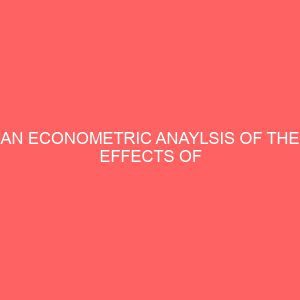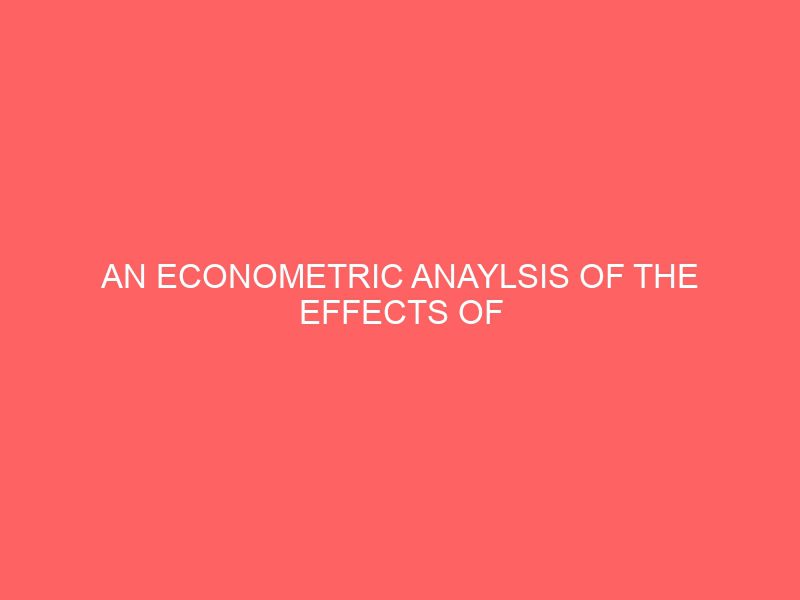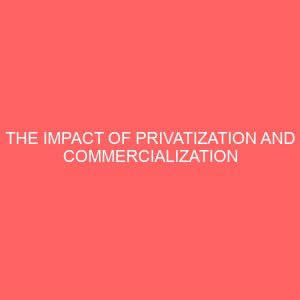Description
ABSTRACT
This study aimed at analyzing through econometric methodology the effects of monetary policy in Nigeria economy. To meet the above objective, output growth was chosen as the dependent variable while real exchange rate, real interest rate and inflation was chosen as the independent variable. The ordinary least square was used in the regression estimation. From the empirical result, we realized that the entire explanatory variables are insignificant in the ttest, but in ftest we rejected the null hypothesis and conclude that the slope coefficient are not simultaneously equal to zero. We realizes from the battery test that there is a co integration between the explanatory band the dependent variables since its level of stationarity are the same.
The policy implication of the result is that if monetary and banking policies are effectively applied, it will be consistent with determining the level of output growth in the economy
CHAPTER ONE
1.0 INTRODUCTION
One of the ways taken by all economy to make the banking sector effective is the use of the monetary policy introduced by the federal government and carried out by the apex bank of the country. Apparently, the existence of an effective banking industry is vital to every economy and it encourages economic growth and development via its role in financial interdiction of funds supplies to deficit economic units .This stimulates international trade, investment economic growth as well employment growth as well as employment.
Monetary policy is one of the steps taken by every economy to make the banking sector effective. Monetary and banking policies are the sole responsibilities of monetary authority, which comprises of The CBN for the initiation, implementation and articulation of monetary system. The CBN carried out these duties on behalf of the federal government according to CBN decree 21 of 1991 and the banks and other financial institution BOFIA A4, of 1991 as amended. The banks proposal on monetary policy is subjective to the federal government.
The policies to be pursued is usually out in form of Audience to all banks and other financial institutions. The guideline are general in operation within a fiscal year but could be amended on the course of the year. The CBN is equally empowered to direct the activities of the financial institutions in other to carry out certain duties in pursuit of approved monetary policy of which penalties are prescribed for noncompliance with specific provision of the guidelines.
1.1 BACKGROUND OF THE STUDY
Monetary policy affects financial and economic activities over the year. In other to appreciate the effects of monetary policy on the banking industry, it would be wise to move a review of changing views of monetary influence. Usually when the quantity of money changes in relation to financial activities as viewed by FISHER 1932. Fisher, take other neoclassical writer who held the view that in short run, money influences real cash balances. According to him, when the money stock increases, example;
An increase commodity prices since output and velocity were fixes initially. He assumed that a rise in commodity prices would exceed the increase in interest rate which was regarded as a component of a firms operating cost. In the whole analysis, rise in commodity prices will lead to an increase in a firms profit, demand, money stock and deposit which will eventually lead to a further rise in investment and commodity price. The excess reserved for lending will decline with interest rate, which was stocky earlier.
In the analysis of long term transmission of monetary influence, Fisher replaced Interest Investment channel with Real Cash Balance. He noted that when wealth rises due to rise in money stock, people tend to reduce their cash balances by purchasing goods and service. Since the velocity v and output y in Fishers equation of exchange MVPT is fixed, the risen money stock M cannot lead to increased holding of goods and services but will lead to decline in prices level P. Keynes 1936 accepted the change in money supply relative has both substitution and effect and considered investment to be quite responsive to interest rates.
Keynes recommended price induce wealth effects, i.e. change in wealth due to change in yields. There are ranging accounts by his interpreters about the extent he integrate them in his general theory. Hence subsequent write to Keynes i.e. Keynesian or post Keynesian regards the cost of capital interest rate as the main process by which changes in money stock influence the economy. Thus the change in volume of money alters the rate of interest. Usually approximated by the long term government bound rate, which affects investment and consumption. Thus the link between wealth of private sector and real sectors and consumption was analyzed by Piguo 1974 and Patikin 1951 in form of real cash balance effect According to them changes in quantities of money would affect aggregate demand even if they did not alter interest rate. On the other hand, credit rationing channel of monetary influence explained how financial interdiction, would be controlled by the market forces so as to ration the supply of credit by non-price mechanism.
Thus an expansionary monetary policy would raise the force of equity i.e. reduce the yield on equities. The margin between the market evaluation and cost of reproducing the existing capital goods will stimulate new investment over those goods. The non-monetarist argued that monetary policy is as effective as fiscal policy as to determine total spending in the economy in spite of their differences. It holds the following views:
1. Movement in quantity of money is the most reliable measure of monetary value.
2. Monetary authority can detect the movement in the stock of money over time and business cycle.
3. Changes in stock of money are the primary determination of total spending as emphasized on owens economic stabilization program.
4. Monetary impulse are transmitted to real economy through an active price process or profit adjustment process which affect many financial and real antes.
1.2 STATEMENT OF PROBLEM
Despite the establishment of Central Bank of Nigeria CBN in 1958, banking industry remained both poor, inadequate in terms of number, quality and variety of service rendered. The establishment of CBN paved way for adoption of monetary management by the banking industry. Just incase any analyst is waiting in the wings to strike CBN for its poor monetary policy performance. Ogwuma 1994:362 offers a defense which says A less than objective appraisal of the CBN role in the Nigerian economy could interpret the adverse macroeconomic trend as evidence of failure on the part of CBN. The key constraint are as follows:
1.3 AIMS AND OBJECTIVES OF THE STUDY
The following issues are the main aims and objectives of carrying out this study;
a. To identify the basic effects of monetary policy in order to
Achieve a sound financial system.
b. To examine CBN monetary policy strategies
c. To identify the best policy measure for economic stability.
1.4 SIGNIFICANT OF THE STUDY
The important of this study cannot be over emphasizes. It will serve as a useful material to the monetary authority, bank management and staff, customers, depositors, students and indeed the entire economy. Never the less, it will add to the volume of studies on the regards. The report shall be useful in ensuring both monetary stability and a sound, safe and profitable banking environment which will facilitate the pace for the economic growth and development in Nigeria.
1.4 HYPOTHESIS / RESEARCH QUESTION
The following hypothesis has been formulated as a guide to the conduct of the study. They should be tested based on the result obtained from the regression coordinated. The hypotheses are;
b. Ho: Variation in monetary policy does not significantly
affect output growth.
c. H1: Variation in monetary policy significantly affect output
growth
i.e. Ho Null Hypothesis
Hi Alternative Hypothesis
1.5 SCOPE OF THE STUDY
Although there exist many factors affecting the operation of or the performance of the banking industry, this study focuses on the impacts of monetary policy on the performance of the banking industry.
1.6 LIMITATION OF THE STUDY
It is quite believed that the study of nature needs sufficient time, finance and materials. The inadequacy of those factors poses enough limitations to this study. The limitations in general include;
a. Financial and monetary constraint
b. Material constraint
c. Time constraint
d. Physical and Geographical constraint
1.8 DEFINITION OF TERMS
1.8.1 BANKING INDUSTRY
These refers to the total number of banks and other financial institution who performs banking function such as acceptance of deposits,. Issuing of credits/loan and keeping of valuables. Such banks include; Merchant Banks and Development Banks etc. The banking industry also consists of the monetary authorities such as Central Bank of Nigeria and other federal bodies whose duty includes the regulation of the economy.
1.8.2 INSURANCE BANK
This implies those banks whose risk are insured with Nigeria Deposit Insurance Commission NDIC
1.8.3 BANK DISTRESS
This is the period in the banking industry when they cannot be able to meet up its target such as; objectives, dividends, staff remuneration in the economy as a whole. In this period, a bank is said to be in the period of solvency, i.e. a period when its debt ratio are high.








Reviews
There are no reviews yet.